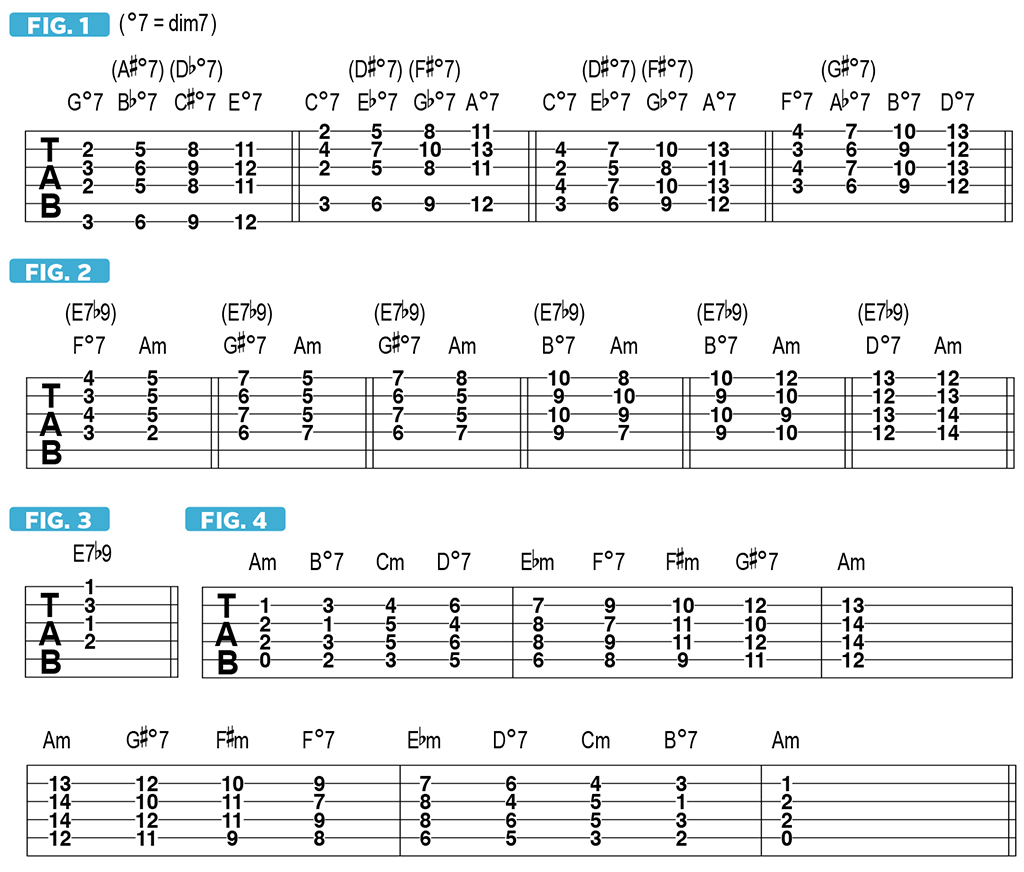The Ultimate Transition Chord: Four Minor Resolutions for dim7
Learn a few interesting applications of this harmonically unstable yet appealing chord.
As a follow-up to our ongoing investigation of ways in which the diminished seven (dim7) chord has been famously used, in this lesson and the next I’ll explain its theoretical basis and demonstrate a few more interesting applications of this harmonically unstable yet appealing chord, including how to link it to a dominant seven (dom7) to increase tension and intensify a five-one resolution. I’ll also illustrate how to employ dim7 as a transitional pivot chord, to modulate surprisingly to a completely different key.
To review, due to dim7’s symmetrical formula of “stacked” minor thirds, moving any dim7 shape up or down three frets on the same string group gives you a structurally identical, parallel inversion of the voicing, comprising the same four notes. And so there are really only three unique dim7 chords, each having four aliases (3 x 4 = 12). For naming simplicity, we can call them Gdim7, Cdim7 and Fdim7.
FIGURE 1 illustrates four different ways to voice and finger these three dim7 chords and their inversions/aliases up the fretboard on different string groups, with two voicing options shown for Cdim7. Each shape may be shifted up or down the fretboard to any key. You’ll notice in the first two sets of voicings (bars 1 and 2) that there’s an unused string between the bottom two notes, resulting in a wider gap of a major sixth interval, providing better sonic clarity in the lower register than a tritone (diminished fifth), which sounds increasingly muddy the lower it’s played.

In music theory, dim7 is the harmonic minor scale’s seventh seventh chord. For example, within the key of A harmonic minor (A B C D E F G#), with its minor sixth and major seventh scale degrees (F and G#), reside all four notes of G#dim7 (G# B D F), which may be thought of as passing tones sandwiched between the notes of an Am triad or arpeggio (A C E). And so G#dim7 resolves naturally to Am, as does its three aliases — Bdim7, Ddim7 and Fdim7, as illustrated in FIGURE 2.
Now, if you were to play any of these four dim7 chords over an E bass note, you’d have what’s called E7b9 (E G# B D F), which in the key of A minor is the V7, or dominant seven, chord with a minor, or “flatted,” ninth interval added (b9). This sour-sounding note creates heightened dissonance within the chord and makes for a more compelling and satisfying resolution to Am than does simply coming from E7 or E. To appreciate this, play FIGURE 2 again, but now pluck your open low E string with every dim7 chord, switching to the open A note with each Am voicing. Or just keep hitting the low E until the final Am chord, for a suspenseful pedal-point effect.
The dominant V7(b9)-to-i minor resolution has been a mainstay in classical music for centuries, used as a means to create drama, and it has been widely employed in popular music of the 20th century as well. A good guitar example of an E7b9 chord’s use can be found in the arpeggiated intro to the 1969 Beatles song “I Want You (She’s So Heavy)” and also for the strummed chord stabs at the end of each verse, for which John Lennon and George Harrison fretted the voicing shown in FIGURE 3.
I’ll conclude today’s lesson with an intriguing “trick,” which is to use the same dim7 shape, inverted up the fretboard, as a pivot chord, to modulate to four completely different, unrelated minor keys (see FIGURE 4). The climbing root motion follows what’s known as the whole-half diminished scale, which is a fascinating musical entity unto itself and a topic for another column.
Senior Music Editor "Downtown" Jimmy Brown is an experienced, working guitarist, performer and private teacher in the greater NYC area whose professional mission is to entertain, enlighten and inspire people with his guitar playing.
Get The Pick Newsletter
All the latest guitar news, interviews, lessons, reviews, deals and more, direct to your inbox!
Over the past 30 years, Jimmy Brown has built a reputation as one of the world's finest music educators, through his work as a transcriber and Senior Music Editor for Guitar World magazine and Lessons Editor for its sister publication, Guitar Player. In addition to these roles, Jimmy is also a busy working musician, performing regularly in the greater New York City area. Jimmy earned a Bachelor of Music degree in Jazz Studies and Performance and Music Management from William Paterson University in 1989. He is also an experienced private guitar teacher and an accomplished writer.








![Joe Bonamassa [left] wears a deep blue suit and polka-dotted shirt and plays his green refin Strat; the late Irish blues legend Rory Gallagher [right] screams and inflicts some punishment on his heavily worn number one Stratocaster.](https://cdn.mos.cms.futurecdn.net/cw28h7UBcTVfTLs7p7eiLe.jpg)


